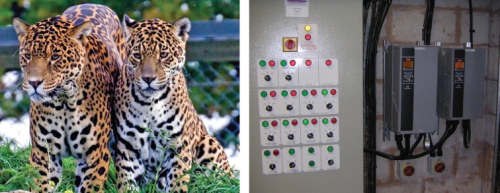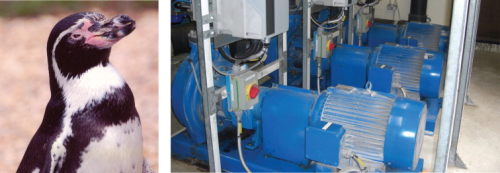

A pdf version of this article is available on the right-hand side, under 'Downloads''
The North of England Zoological Society (NEZS) runs Chester Zoo, the UK's number one charity zoo, with 1.3 million visitors each year, caring for over 7,000 animals, representing over 400 different species and contributing significantly to their protection through a combination of zoo and field based conservation.
Installing variable speed drives
JBC Controls, in conjunction with Danfoss Drives, have installed variable speed drives (VSDs) in three of its animal enclosures; Spirit of the Jaguar, Elephants of the Asian Forest and the penguin enclosure. Existing systems were upgraded in order to save energy and increase efficiency. As Glyn Berry, sales director of JBC Controls explains: “All drives have been retrofitted adjacent to the plant they control as the plant is existing we have had to rewire the fans supplies to comply with the current EMC directive and standards set out by Danfoss. The beauty of the drives being in IP55 enclosures meant there was no need to provide additional protective enclosures.”
Working in collaboration
JBC Controls and Chester Zoo have a longstanding relationship and have been working on projects together for the last five years. This combination of applications is the largest single energy saving project undertaken to date and looks to be the most rewarding according to the statistical data gathered since the addition of the VSDs, achieving benefits of a financial nature in terms of reduced running costs whilst improving animal welfare.
Elephant house
The area where the greatest success has been realised is in the elephant house. Optimisation of controls via the installation in August 2008 of an outside air temperature sensor to the BMS controls enables determination of the modes of operation between the summer and winter setting based on ambient air. This optimisation, the installation of the Danfoss drives and a ‘demand matched’ ventilation strategy has resulted in energy savings of up to 78% being recorded; 55% of the savings are directly attributable to the drives, which were installed at the end of July 2008.
The forecasted cube law savings have been realised in this application, i.e. a reduction in speed of 20%, has reduced energy consumption in excess of 50%. The ability to control speed has eliminated motor start/stop noise which could potentially disturb the elephants, an unforeseen welfare enhancement benefit for animal management purposes.
Penguin enclosure
The water filtration plant in the penguin enclosure has three 18.5 kW drives (2 duty & 1 standby, all installed mid February 2008) which control water circulation to the pool area and automatically reduce the flow of water to 70% at night via a time programme. Improvements were not as dramatic as those recorded in the elephant house, but the positive effect was evident immediately after installation of the drives.
The average energy savings per month to date of 40% in this area are directly attributable to the drives. The total cost of electricity in 2008 was £29,000 and the estimated penguin plant electricity bill at the end of 2009 is £17,000 based on YTD consumption figures, a potential cost saving of £12,000. Payback is clear to see, the cost of installing and commissioning the drives was around £10,000, meaning that within 12 months, Chester Zoo may profit from a greater return on their investment than projected. Two more unexpected benefits are reduced noise in the plant room, together with improved water quality due to the greater effective use of continuous ultra violet light.
Jaguar enclosure
The jaguar enclosure has two drives (11 kW and 7.5 kW) controlling the surrounding fresh air in a similar manner to the elephant area, via a BMS control. The ventilation system is enabled by heating or cooling demand from room temperature sensors. In addition, should the system be off and the CO2 level increase, the system is automatically enabled.
The application of VSDs has enabled the zoo to optimise efficiency by adopting a ‘demand matching’ controls strategy, fundamental to the reduction in energy consumption on the associated HVAC equipment in both the elephant house and the jaguar enclosure. Previously motors had to run 24 hours a day at one speed. Now for the first time the zoo is able to match the speed of the motor (or the pump in the case of the penguins) to the demand of the system, switch the AHU off if heat, cold or a change in air quality is not required for example. Ventilation and seasonal demands can now be easily met with no adverse effect on environmental conditions.
Environmental performance
Ray Morrison, who has been maintenance manager at Chester Zoo for ten years, explains how environmental performance is equally as important as financial performance. “At Chester Zoo we adopt the principle of triple accounting, our performance is measured by how well we perform financially, environmentally and in terms of corporate social responsibility.” Ray goes on to explain how the zoo takes its responsibility for the environment very seriously. “Every £1 saved is £1 that can be re-invested in animal welfare and conservation projects world wide, such as supporting Asian elephants in their natural habitat in the wild.”
As part of Chester Zoo's compliance of Environmental Management Standard ISO14001, awarded to the Zoo in 2004, the company pledges in its environmental policy statement “to achieve such improvements in environmental performance, the Zoo has set, and will maintain, review and revise, environmental objects and targets with the aim of continually improving our environmental performance.” Chester Zoo was the first zoo in the UK and the first major zoo in Europe to gain accreditation and see this International Management Standard as their bible in terms of demonstrating and improving their environmental credentials. This commitment was once again recognised in 2006 when Chester Zoo received the coveted Queens Award for Enterprise in the category of Sustainable Development.
Chester Zoo is currently implementing its Energy Management Plan, aimed at delivering energy conservation and efficiency by developing operational and technological excellence in order to reduce environmental impact and control costs. Energy usage is constantly monitored using data loggers in various ‘high consumption’ buildings to identify opportunities for renewable technologies. The building's environmental assessment method BREEAM has also been adopted in relation to the zoo's capital development programme. A long term plan is to become carbon neutral, aiming for a 10% reduction in energy consumption which is a significant saving across their complex 110 acre site.
Saving and protecting
The purchase and installation of Danfoss VSDs via JBC Controls is seen by all parties as a major step towards continual global environmental compliance and best practice, with an estimated £3,000 reduction in monthly energy costs at Chester Zoo. This long term investment supports the zoo's proven track record in demonstrating its significant contribution to the protection of animals and reinforces its dedication to sustainability.





